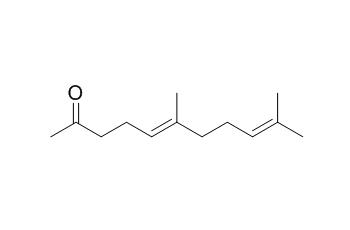Geranylacetone
Geranylacetone is a TRPV1 agonist; it is also a potent inhibitor of β-secretase (BACE1), it may have potential treatment for Alzheimer's disease.
Inquire / Order:
manager@chemfaces.com
Technical Inquiries:
service@chemfaces.com
Tel:
+86-27-84237783
Fax:
+86-27-84254680
Address:
1 Building, No. 83, CheCheng Rd., Wuhan Economic and Technological Development Zone, Wuhan, Hubei 430056, PRC
Providing storage is as stated on the product vial and the vial is kept tightly sealed, the product can be stored for up to
24 months(2-8C).
Wherever possible, you should prepare and use solutions on the same day. However, if you need to make up stock solutions in advance, we recommend that you store the solution as aliquots in tightly sealed vials at -20C. Generally, these will be useable for up to two weeks. Before use, and prior to opening the vial we recommend that you allow your product to equilibrate to room temperature for at least 1 hour.
Need more advice on solubility, usage and handling? Please email to: service@chemfaces.com
The packaging of the product may have turned upside down during transportation, resulting in the natural compounds adhering to the neck or cap of the vial. take the vial out of its packaging and gently shake to let the compounds fall to the bottom of the vial. for liquid products, centrifuge at 200-500 RPM to gather the liquid at the bottom of the vial. try to avoid loss or contamination during handling.
Chemistry of Natural Compounds2019, 55(1):127-130
Plant Cell,Tissue & Organ Culture2016, 127(1):115-121
Int J Cosmet Sci.2022, doi:10.1111/ics.12827.
J Nat Prod.2015, 78(6):1339-4
Chung Shan Medical University2020, US20200323790A1
Int J Mol Sci.2023, 24(3):2102.
Ajou University2024, 4688116
Acta Physiologiae Plantarum2015, 37:1736
Nutr Res Pract2019, 13:e45
Environ Toxicol.2024, 39(5):2927-2936.
Related and Featured Products
J Agric Food Chem. 2016 Sep 28;64(38):7156-70.
Modulation of Human Neutrophil Responses by the Essential Oils from Ferula akitschkensis and Their Constituents.[Pubmed:
27586050 ]
Essential oils were obtained by hydrodistillation of the umbels+seeds and stems of Ferula akitschkensis (FAEOu/s and FAEOstm, respectively) and analyzed by gas chromatography and gas chromatography-mass spectrometry.
METHODS AND RESULTS:
Fifty-two compounds were identified in FAEOu/s; the primary components were sabinene, α-pinene, β-pinene, terpinen-4-ol, eremophilene, and 2-himachalen-7-ol, whereas the primary components of FAEOstm were myristicin and Geranylacetone. FAEOu/s, β-pinene, sabinene, γ-terpinene, Geranylacetone, isobornyl acetate, and (E)-2-nonenal stimulated [Ca(2+)]i mobilization in human neutrophils, with the most potent being Geranylacetone (EC50 = 7.6 ± 1.9 μM) and isobornyl acetate 6.4 ± 1.7 (EC50 = 7.6 ± 1.9 μM). In addition, treatment of neutrophils with β-pinene, sabinene, γ-terpinene, Geranylacetone, and isobornyl acetate desensitized the cells to N-formyl-Met-Leu-Phe (fMLF)- and interleukin-8 (IL-8)-induced [Ca(2+)]i flux and inhibited fMLF-induced chemotaxis. The effects of β-pinene, sabinene, γ-terpinene, Geranylacetone, and isobornyl acetate on neutrophil [Ca(2+)]i flux were inhibited by transient receptor potential (TRP) channel blockers. Furthermore, the most potent compound, Geranylacetone, activated Ca(2+) influx in TRPV1-transfected HEK293 cells. In contrast, myristicin inhibited neutrophil [Ca(2+)]i flux stimulated by fMLF and IL-8 and inhibited capsaicin-induced Ca(2+) influx in TRPV1-transfected HEK293 cells.
CONCLUSIONS:
These findings, as well as pharmacophore modeling of TRP agonists, suggest that Geranylacetone is a TRPV1 agonist, whereas myristicin is a TRPV1 antagonist. Thus, at least part of the medicinal properties of Ferula essential oils may be due to modulatory effects on TRP channels.
J Oleo Sci. 2017 Aug 1;66(8):851-855.
Inhibition of β-Secretase Activity by Monoterpenes, Sesquiterpenes, and C13 Norisoprenoids.[Pubmed:
28381772 ]
Inhibition of β-secretase (BACE1) is currently regarded as the leading treatment strategy for Alzheimer's disease.
METHODS AND RESULTS:
In the present study, we aimed to screen the in vitro inhibitory activity of 80 types of aroma compounds (monoterpenes, sesquiterpenes, and C13 norisoprenoids), including plant-based types, at a 200-μM concentration against a recombinant human BACE1. The results showed that the most potent inhibitor of BACE1 was geranyl acetone followed by (+)-camphor, (-)-fenchone, (+)-fenchone, and (-)-camphor with the half-maximal inhibitory concentration (IC50) values of 51.9 ± 3.9, 95.9 ± 11.0, 106.3 ± 14.9, 117.0 ± 18.6, and 134.1 ± 16.4 μM, respectively. Furthermore, the mechanism of inhibition of BACE1 by Geranylacetone was analyzed using Dixon kinetics plus Cornish-Bowden plots, which revealed mixed-type mode.
CONCLUSIONS:
Therefore aroma compounds may be used as potential lead molecules for designing anti-BACE1 agents.



